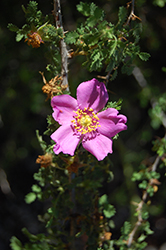It's all about ...
plants

Height: 4 feet
Spread: 4 feet
Sunlight:
![]()
Hardiness Zone: 8b
Other Names: Baja Rose, Ensenada Rose, Littleleaf Rose
Description:
A drought tolerant, native rose variety, featuring a profusion of lightly fragrant, small pink flowers from early spring to mid-summer; distinguished by its tiny, deeply cut foliage; summer deciduous in dry conditions; needs full sun and well-drained soil
Ornamental Features
Small-leaved Rose features showy lightly-scented hot pink flowers with gold eyes at the ends of the branches from early spring to mid summer. It has attractive green evergreen foliage which emerges light green in spring. The tiny deeply cut oval compound leaves are highly ornamental and remain green throughout the winter. The fruits are showy red hips with orange overtones, which are carried in abundance from early fall to mid winter. The spiny gray bark and brick red branches add an interesting dimension to the landscape.
Landscape Attributes
Small-leaved Rose is a multi-stemmed evergreen shrub with a more or less rounded form. It lends an extremely fine and delicate texture to the landscape composition which can make it a great accent feature on this basis alone.
This is a high maintenance shrub that will require regular care and upkeep, and should never be pruned except to remove any dieback, as it tends not to take pruning well. It is a good choice for attracting bees and butterflies to your yard. Gardeners should be aware of the following characteristic(s) that may warrant special consideration;
- Spiny
Small-leaved Rose is recommended for the following landscape applications;
- Accent
- Mass Planting
- Hedges/Screening
- Rock/Alpine Gardens
- General Garden Use
- Naturalizing And Woodland Gardens
Planting & Growing
Small-leaved Rose will grow to be about 4 feet tall at maturity, with a spread of 4 feet. It tends to fill out right to the ground and therefore doesn't necessarily require facer plants in front. It grows at a slow rate, and under ideal conditions can be expected to live for approximately 30 years. As this plant tends to go dormant in summer, it is best interplanted with late-season bloomers to hide the dying foliage. This is a dioecious species, meaning that individual plants are either male or female. Only the females will produce fruit, and a male variety of the same species is required nearby as a pollinator.
This shrub should only be grown in full sunlight. It prefers dry to average moisture levels with very well-drained soil, and will often die in standing water. It is considered to be drought-tolerant, and thus makes an ideal choice for xeriscaping or the moisture-conserving landscape. This plant will benefit from an application of bonemeal and/or mycorrhizal fertilizer at the time of planting. It is not particular as to soil type or pH, and is able to handle environmental salt. It is somewhat tolerant of urban pollution. Consider applying a thick mulch around the root zone over the growing season to conserve soil moisture. This species is native to parts of North America.
This plant is not reliably hardy in our region, and certain restrictions may apply; contact the store for more information.
